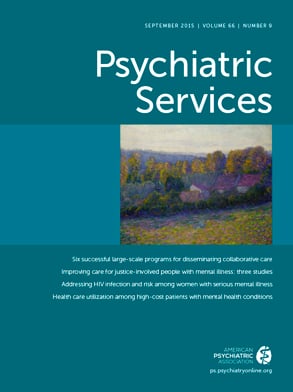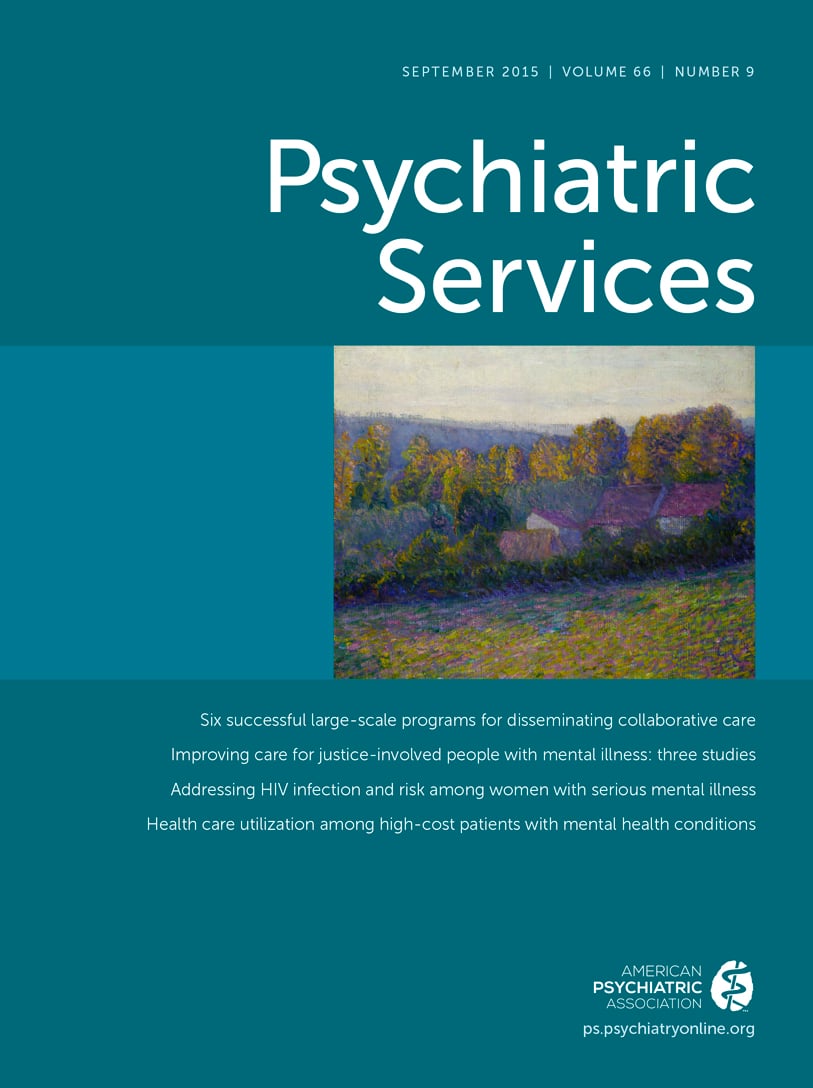Over the past decade, the problem of chronic homelessness has received significant attention from policy makers, service providers, researchers, and other stakeholders (
1–
3). Interest in chronic homelessness stems, in part, from evidence that individuals who experience long-term or repeated episodes of homelessness are a small minority of all persons who experience homelessness but consume the bulk of emergency shelter resources (
4). These individuals have higher rates of behavioral and general medical conditions compared with persons who experience homelessness on a short-term basis, and they also make frequent and costly use of acute general medical, behavioral, criminal justice, and other services (
2,
5). Studies show that permanent supportive housing (PSH)—broadly defined as subsidized housing matched with ongoing supportive services—can lead to improvements in residential stability and reductions in acute care services among persons experiencing chronic homelessness (
6–
8).
The federal government has been a leader in efforts to end chronic homelessness (
1). In 2003, the Department of Housing and Urban Development (HUD) established an official definition of chronic homelessness as part of the first targeted federal initiative on chronic homelessness (
9). The definition requires that an individual “either [have] been continuously homeless for a year or more or [have] had at least four episodes of homelessness in the past three years.” The definition also includes a disability criterion, which encompasses a range of behavioral, general medical, and development disabilities. This definition, ostensibly, is meant to identify high-need individuals who have experienced homelessness for a significant amount of time. However, the term “episode” was never defined, leading to concerns that the HUD definition is inadequate for differentiating between persons with extended histories of homelessness and the general population of persons who are homeless. Indeed, according to the most literal interpretation of the definition, a person who used a shelter on Sunday, Tuesday, Thursday, and Saturday of a single week and then never again would be considered chronically homeless.
Recognizing these limitations, HUD has recently proposed a new definition of chronic homelessness that revises the criteria for an episode of homelessness in order to better identify individuals with the longest histories of homelessness (
10). Identifying such individuals is potentially important for ensuring that more intensive housing interventions, such as PSH, are targeted to persons who are likely to need them the most and to derive the most benefit from them. However, it remains unclear whether the proposed definition is preferable to the existing definition for identifying persons with the most protracted homeless experiences. In addition, the effect of the new definition on the number of individuals who are counted as chronically homeless remains unknown, but it will certainly affect planning decisions about the type and amount of resources needed to address the problem. It is also important to examine how changes in definition may affect the number of persons identified as new entrants into chronic homelessness over time. However, there has been no prior attempt to examine new entrants into chronic homelessness, despite the fact that information to this effect could help communities set targets for the number of PSH units needed to address chronic homelessness (
11).
This study used records from the emergency shelter system in a large city to assess the potential impact of a proposed change in HUD’s definition of chronic homelessness and to examine several possible alternative definitions of chronic homelessness. We compared both the number of persons identified as chronically homeless under each definition and the extent to which each definition identified the heaviest users of shelter. We also estimated the number of individuals who became chronically homeless over the course of a year under these definitions.
Methods
This study used administrative data from the emergency shelter system in a large U.S. city covering the period from January 1, 2009, to December 31, 2012. These data included all entries into and exits from shelters serving single adults. We used these data to estimate the number of persons who would be identified as chronically homeless under the current and proposed new HUD definitions and two alternative definitions proposed during a special session on the definition of chronic homelessness (
12). Because disability status was not available in the data, we identified persons meeting each definition solely on the basis of their shelter utilization. This approach has been used in prior research (
5).
As described above, the current HUD definition requires that an individual “either [have] been continuously homeless for a year or more or [have] had at least four episodes of homelessness in the past three years.” We defined distinct episodes as shelter stays separated by periods of 30 days or longer in which there was no record of having used shelter. The proposed HUD definition requires a continuous episode of homelessness of one year or more or four or more episodes of homelessness (as defined above) over a three-year period with a cumulative duration of at least 365 days. Alternative definition 1 includes a continuous episode of homelessness of 365 days or longer or a cumulative total of ≥365 days of homelessness over a three-year period, with no criteria for an episode of homelessness. Alternative definition 2 includes a continuous episode of homelessness of 365 days or longer or a record of any shelter use during a cumulative total of 12 or more unique months over a three-year period.
We estimated the number of individuals who satisfied each of these definitions as of January 1, 2012 (on the basis of shelter use in 2009–2011) and as of December 31, 2012 (on the basis of shelter use in 2010–2012). We also examined utilization of emergency shelter during 2010–2012 to test which definition identified persons who made the heaviest use of emergency shelter.
Results
Table 1 shows that under the current HUD definition, 14% of all those who had a shelter stay between 2010 and 2012 in a large U.S. city met either the continuous-homelessness or multiple-episodes criterion for chronic homelessness. These individuals accounted for about 38% of all shelter days used from 2010–2012. A large majority (80%) of persons who were identified as chronically homeless at the beginning of 2012 or who became chronically homeless over the course of 2012 met the episode criterion. However, compared with persons who met the multiple-episodes criterion, persons who met the continuous-homelessness criterion spent more days, on average, in shelter and made more disproportionate use of shelter as indicated by the ratio of percentage of days of use versus percentage of users. The number of persons who became chronically homeless in 2012 via the multiple-episodes criterion was less than one-third as large as the number who met the criterion at the start of 2012. By contrast, the number of persons who became chronically homeless in 2012 on the basis of the continuous-homelessness criterion was only slightly lower than the number who met the criterion at the start of 2012.
Roughly 6% of all those who used shelter between 2010 and 2012 met the proposed new HUD definition of chronic homelessness, less than half as many who met the current definition. Although a majority (57%) met the multiple-episodes criterion, the distribution of those who met the multiple-episodes criterion and the continuous-stay criterion was more balanced under the new definition compared with the current definition. Overall, persons who met the new definition of chronic homelessness used 29% of all shelter days and made heavier use of shelter compared with persons who met the existing definition. During 2012, fewer than half as many people met criteria for chronic homelessness via the multiple-episodes criterion under the proposed new definition compared with the existing one.
A slightly higher percentage of individuals (∼16%) met alternative definition 1 compared with the current definition. Persons who met alternative definition 1 accounted for more than half of all shelter days used between 2010 and 2012, and their use of shelter was heavier compared with persons who met the current definition but less heavy than persons who met the proposed new HUD definition. The results were similar for persons who met alternative definition 2.
Discussion
This study indicates that a proposed change to the definition of chronic homelessness may have a sizable impact on the number of persons identified as chronically homeless. Fewer than half as many single adults who met the current definition satisfied the proposed new definition. This finding is important because it suggests that the number of persons counted as chronically homeless—roughly 93,000 individuals nationwide on a single night (
13)—may drop substantially under the new definition. Whereas more than 80% of persons who met the existing definition of chronic homelessness did so via the multiple-episodes criterion rather than the continuous-homelessness criterion, 57% of persons who satisfied the proposed new definition did so under the multiple-episodes criterion.
Although a smaller group, persons identified as chronically homeless under the new definition were found to make much heavier use of shelter. This finding suggests that the proposed new definition is better suited for identifying persons who remain homeless for extended periods of time. From a programmatic perspective, use of the new definition may mean that PSH and other housing programs intended specifically for those experiencing chronic homelessness would serve a more vulnerable population.
Notably, the findings are contingent on how we defined an episode of homelessness. A shortcoming of the proposed new HUD definition is that it does not resolve the question of how to define an episode. The two alternative definitions we tested did not include an episode criterion, and persons satisfying these alternative definitions made more disproportionate use of shelter compared with persons who met the existing definition. Thus, both alternative definitions 1 and 2 are also preferable to the existing definition, and they also obviate the need to define an episode of homelessness.
We found that the number of persons who met the current and proposed new definitions for chronic homelessness on the basis of the continuous-homelessness criterion at some point during 2012 was nearly as large as the number who did so at the beginning of the year. By contrast, a smaller proportion of persons who met these definitions on the basis of the episode criterion did so during 2012 compared with at the beginning of the year.
The two key limitations of this study were the lack of information in the available data about the presence of a disabling condition, which likely resulted in an overestimate of the number of persons identified as chronically homeless, and the use of data from a single jurisdiction, which is not likely to be representative of communities with different economic, housing, and service system characteristics.
Conclusions
Our findings suggest that a proposed new definition and two alternative definitions of chronic homelessness are preferable to the current one because they performed better in identifying persons who remained homeless for extended periods of time. Of the three, the proposed new HUD definition appears to be best suited for identifying the heaviest users of shelter, at least under the definition of episode of homelessness employed in this study.

